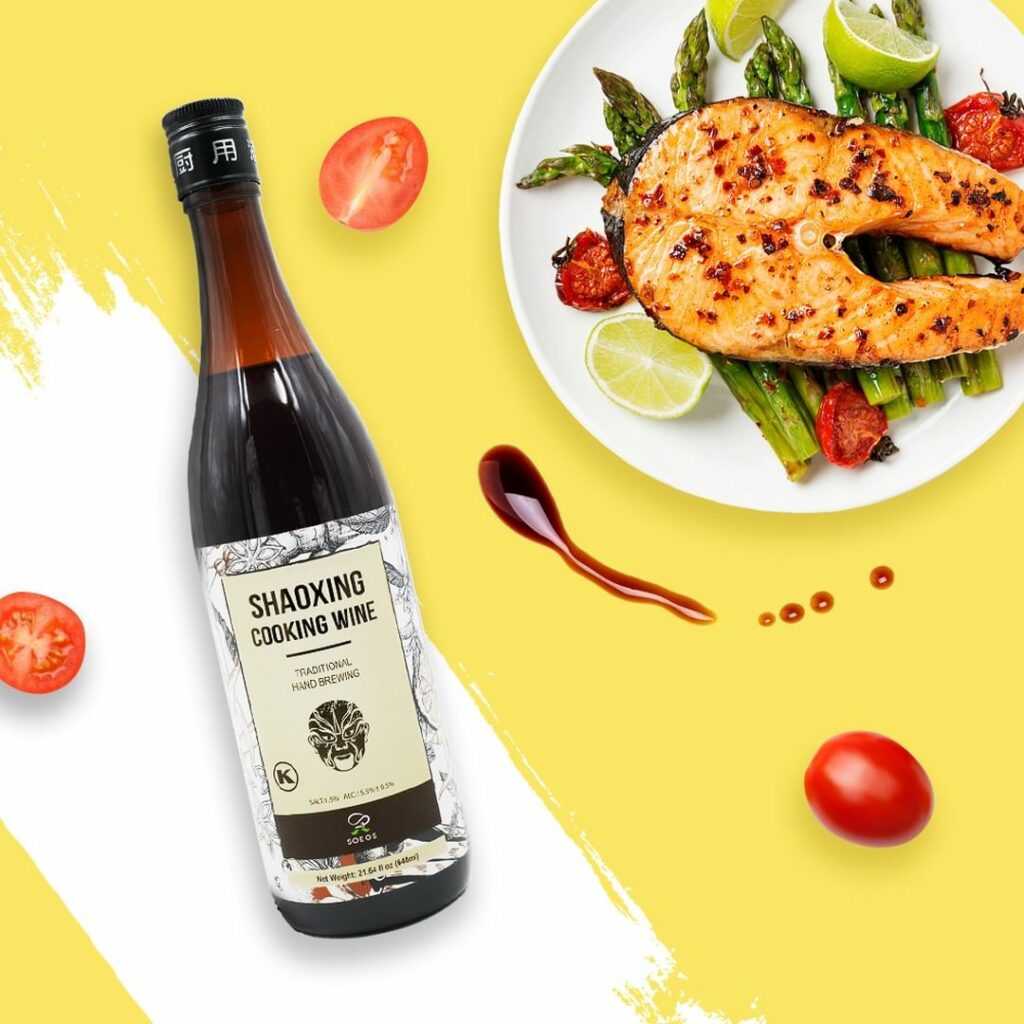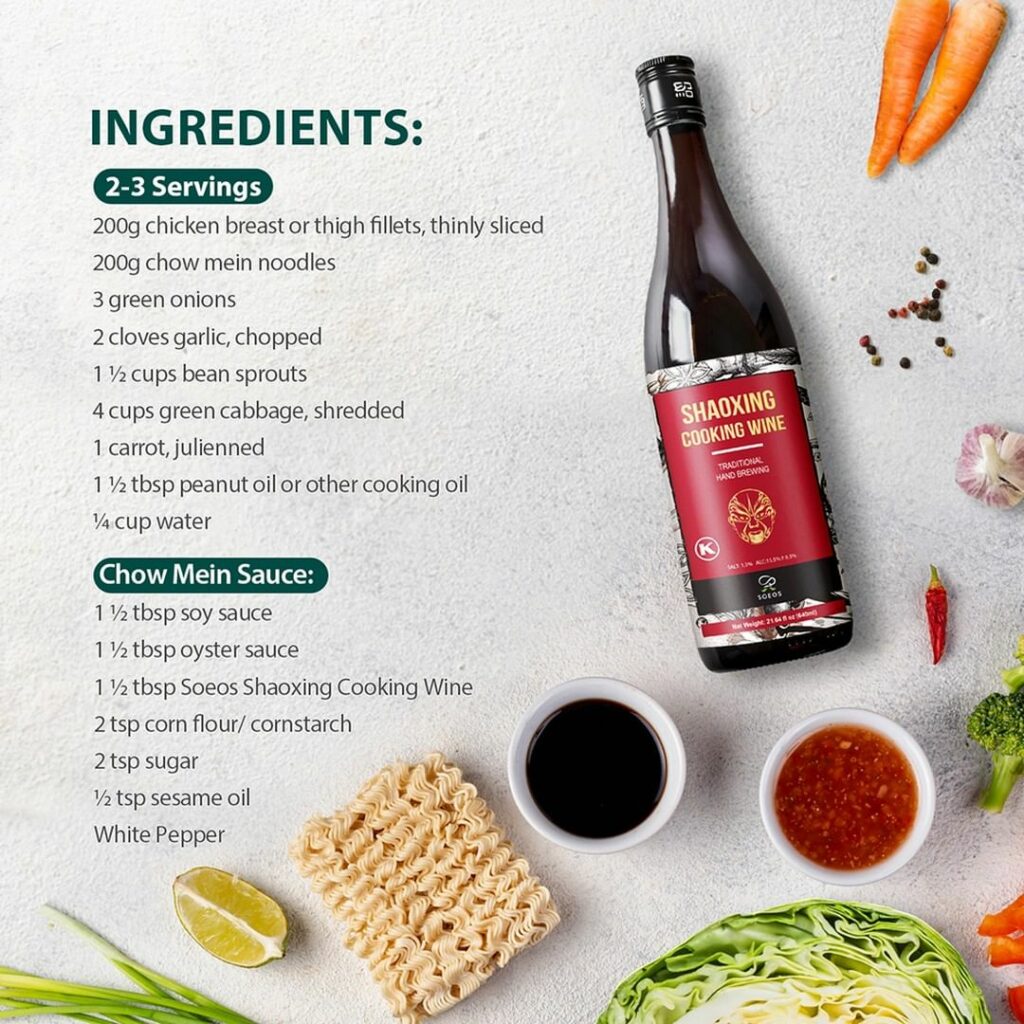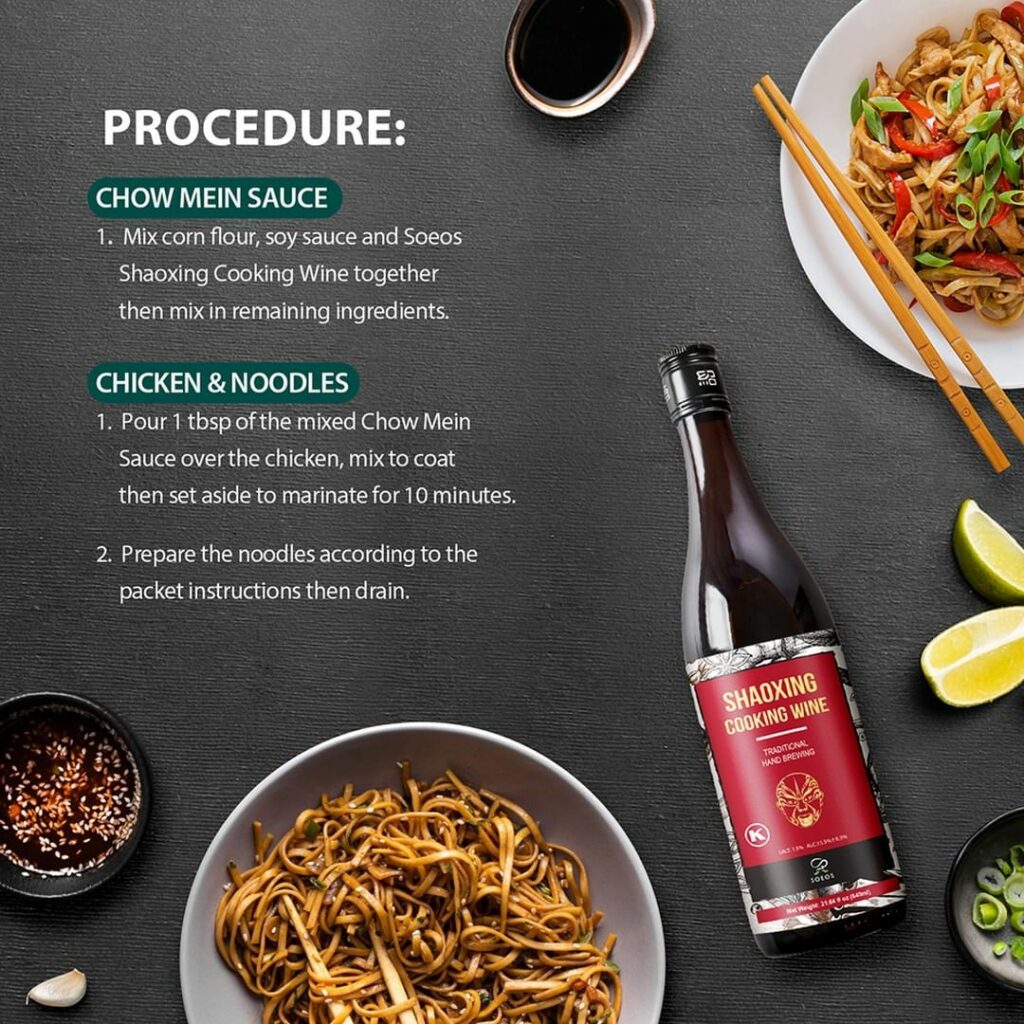Shaoxing wine, a prominent ingredient in Chinese cuisine, holds immense significance for its unique flavor profile and ability to enhance dishes. However, there are situations that call for Shaoxing wine substitute.
Whether due to non-alcoholic preferences or unavailability, finding suitable alternatives becomes essential. This article explores the world of Shaoxing wine substitutes, guiding you towards discovering flavorful options that can enrich your culinary creations.
What is Shaoxing wine?

Shaoxing wine is a type of Chinese rice wine that originates from the city of Shaoxing in Zhejiang province. With a rich history dating back over 2,500 years, it is renowned for its distinct aroma and complex flavor profile. Made from fermented glutinous rice, the wine undergoes a lengthy aging process to develop its unique characteristics.
In Chinese cooking, Shaoxing wine is a staple ingredient used for marinating, braising, and stir-frying. Its umami-rich taste adds depth and complexity to various dishes, such as drunken chicken, Dongpo pork, and steamed fish. The wine’s ability to tenderize meat and impart a rich savory note makes it an indispensable component in traditional Chinese cuisine.
Why substitute Shaoxing wine?
There are several scenarios where substituting Shaoxing wine becomes necessary. One common reason is non-alcoholic preferences, where individuals may choose to avoid alcoholic beverages in their cooking. In such cases, finding suitable non-alcoholic substitutes ensures that the flavor profile of the dish remains intact.
Another situation that calls for Shaoxing wine substitutes is unavailability. Shaoxing wine may not be readily accessible in all regions, making it challenging for cooks to incorporate it into their recipes. Finding alternatives allows for the exploration of similar flavor profiles without compromising the authenticity of the dish.
Regardless of the reason, it is important to seek out suitable Shaoxing wine substitutes to maintain the distinctive characteristics it brings to Chinese cuisine. By carefully selecting alternatives that offer similar flavors and depth, one can ensure that the essence of the original dish is preserved, allowing for a satisfying culinary experience
What are the advantages and disadvantages of Shaoxing wine substitutes?
| Advantages of Shaoxing Wine Substitutes | Disadvantages of Shaoxing Wine Substitutes |
| Widens accessibility for non-alcoholic preferences | May alter the overall flavor profile of the dish |
| Offers alternatives in regions where Shaoxing wine is unavailable | Different substitutes may not provide the exact complexity of Shaoxing wine |
| Provides flexibility for individuals with dietary restrictions | Some substitutes may not have the same aging process, resulting in a different taste |
| Allows for experimentation and creative culinary ventures | Requires careful selection to ensure a suitable substitute |
| Can be more cost-effective in certain cases | May require adjustments in proportions and cooking techniques |
It’s important to note that the advantages and disadvantages of Shaoxing wine substitutes can vary depending on the specific substitute chosen and the desired flavor profile of the dish. Experimentation and personal preference play a significant role in determining the success of using substitutes.
What is a key ingredient of Shaoxing wine?
The key ingredient of Shaoxing wine is:
Glutinous Rice: Shaoxing wine is primarily made from fermented glutinous rice, which gives it its distinctive flavor and character.
What are the top 10+ Shaoxing wine substitute?

Adjust the quantities and flavors of the substitutes according to personal preference and the specific dish being prepared to achieve the desired results, substitute shaoxing cooking wine including:
Huadiao wine
Huadiao wine is a popular substitute for Shaoxing wine. It shares a similar origin and flavor profile, offering a mellow and slightly sweet taste with hints of nuttiness. Use it in marinades, braised dishes, and stir-fries to bring depth and complexity to your recipes.
Rice wine
Rice wine, commonly used in Chinese cooking, serves as an excellent alternative to Shaoxing wine. It has a mild and slightly sweet flavor, imparting a delicate taste to dishes. Use it in stir-fries, marinades, and sauces to add a subtle richness to your creations.
Dry sherry
Dry sherry is a fortified wine with a nutty flavor profile, making it a suitable substitute for Shaoxing wine. It adds depth and complexity to dishes, particularly in braised meats and savory sauces.
Mirin
Mirin, a sweet Japanese rice wine, can be used as a substitute for Shaoxing wine. It offers a mild sweetness and imparts a glossy finish to dishes. It works well in stir-fries, glazes, and marinades.
Marsala wine
Marsala wine, an Italian fortified wine, can provide a rich and robust flavor similar to Shaoxing wine. It adds depth to sauces, stews, and meat dishes, creating a savory profile.
Red wine
In certain recipes, you can replace Shaoxing wine with red wine. While it may not offer the exact flavor profile, red wine adds complexity and richness to braised meats, stews, and sauces.
Grape juice
For non-alcoholic alternatives, grape juice can be used as a substitute for Shaoxing wine. It brings a slightly sweet and fruity note to dishes, enhancing flavors in marinades, glazes, and stir-fries.
Vinegar blend
Creating vinegar blends by combining rice vinegar, apple cider vinegar, and a touch of sugar can mimic the tanginess of Shaoxing wine. Adjust the proportions to balance the flavors and use it in stir-fries, marinades, and sauces.
Sake
Sake, a Japanese rice wine, can be used as a substitute for Shaoxing wine in certain dishes. It provides a light, slightly sweet taste and works well in seafood dishes, soups, and marinades.
White Wine
White wine can be used as a substitute for Shaoxing wine in some recipes. Although the flavor profile differs, it can offer a pleasant depth and acidity to dishes, especially in sauces and seafood recipes.
Read more: White Vinegar Vs White Wine Vinegar
Vermouth
Vermouth, a fortified wine flavored with herbs and spices, can add complexity and depth to dishes as a substitute for Shaoxing wine. It works well in sauces, braised dishes, and risottos.
Vegetable broth
In vegetarian or vegan recipes, vegetable broth can replace Shaoxing wine to add depth and flavor. While it won’t replicate the exact taste, it can enhance savory dishes and provide a rich base.
Exploring Non-Alcoholic Shaoxing wine substitutes
As the demand for non-alcoholic options in cooking continues to rise, the need for non-alcoholic substitutes for Shaoxing wine becomes apparent. Many individuals prefer to avoid alcohol for personal, cultural, or health reasons but still want to enjoy the flavors and aromas that Shaoxing wine imparts to their dishes.
Fortunately, there are several non-alcoholic substitutes available that can mimic the essence of Shaoxing wine. One such substitute is grape juice, which offers a mildly sweet and fruity flavor, similar to the natural sweetness found in Shaoxing wine. By using grape juice as a substitute, you can add a touch of complexity and depth to your dishes without the presence of alcohol.
Another option is to use vinegar blends as a non-alcoholic alternative to Shaoxing wine. Combining different types of vinegar, such as rice vinegar, apple cider vinegar, and a dash of sugar, can help replicate the tangy acidity and subtle sweetness that Shaoxing wine brings to recipes.
These non alcoholic shaoxing wine substitute provide an excellent solution for those seeking to avoid alcohol while still incorporating the flavors and nuances associated with Shaoxing wine. However, it’s essential to adjust the proportions and experiment with different combinations to achieve the desired taste in your dishes.
What is substituting Shaoxing cooking wine with similar varieties?
When it comes to substituting Shaoxing cooking wine, there are alternative types of Chinese cooking wines that can be used as suitable replacements. Two popular options are Huadiao wine and rice wine, which share similarities with Shaoxing wine in terms of flavor profiles and their applicability in recipes.
- Huadiao wine, also known as Hua Diao Jiu, is a type of Chinese rice wine that hails from the Shaoxing region. Like Shaoxing wine, it undergoes a fermentation and aging process, resulting in a rich, amber-colored wine with a mellow and slightly sweet taste. Huadiao wine can be used as a substitute for Shaoxing wine in recipes that call for its distinct flavor, providing a comparable depth and complexity.
- Rice wine, a staple in Chinese cooking, is another alternative to Shaoxing wine. Made from fermented glutinous rice, rice wine offers a mild and slightly sweet flavor. It is widely used in marinades, stir-fries, and braised dishes, serving as a suitable replacement for Shaoxing wine when the latter is unavailable or desired. The versatility of rice wine makes it an excellent substitute that can still contribute to the desired flavor profiles of various recipes.
Both Huadiao wine and rice wine can be employed as substitutes for Shaoxing cooking wine, allowing you to maintain the essence and authenticity of Chinese cuisine.
It is important to note that while these alternatives share similarities with Shaoxing wine, there may be slight variations in taste, so adjustments to proportions and flavor balancing might be necessary to achieve the desired results in your dishes.
Try these Chinese recipes
How to Shaoxing wine substitute in specific dishes?

When substituting Shaoxing wine in specific dishes, it’s crucial to select the right alternative to ensure that the desired flavors are achieved. Here are two popular recipes where Shaoxing wine plays a crucial role, along with specific substitutes and instructions for each dish:
Drunken Chicken
- Original Recipe: This traditional dish typically involves marinating chicken in Shaoxing wine, ginger, and other seasonings. The wine adds depth and aroma to the meat.
- Substitute: For a non-alcoholic version, replace Shaoxing wine with a combination of chicken broth or stock, a small amount of rice vinegar, and a pinch of sugar. This blend will provide a similar tangy flavor to the dish.
- Instructions: Marinate the chicken in the substitute mixture along with ginger, garlic, and other desired seasonings. Proceed with the rest of the recipe as usual.
Braised Pork
- Original Recipe: Braised pork dishes often call for Shaoxing wine to enhance the richness and tenderness of the meat, as well as add depth to the sauce.
- Substitute: Rice wine or dry sherry can be used as substitutes for Shaoxing wine in braised pork recipes. Both options offer a similar flavor profile and contribute to the desired richness.
- Instructions: Replace the Shaoxing wine called for in the recipe with an equal amount of rice wine or dry sherry. Follow the remaining steps of the braised pork recipe as instructed.
It’s important to note that while these substitutes can mimic the flavors of Shaoxing wine, the overall taste may have slight variations. Adjustments may be required to balance the flavors according to your preference.
Additionally, for those who prefer non-alcoholic substitutes, incorporating vinegar blends or grape juice can provide a comparable tangy or fruity profile, respectively.
How to store Shaoxing wine substitute?
- Non-Alcoholic Substitutes: If you are using non-alcoholic alternatives like grape juice or vinegar blends, store them in a cool, dry place away from direct sunlight. Seal the containers tightly to prevent oxidation and maintain freshness. It’s advisable to refrigerate opened bottles of grape juice to prolong their shelf life.
- Rice Wine or Dry Sherry: For substitutes such as rice wine or dry sherry, store them in a cool, dark place, like a pantry or cellar. Make sure the bottles are tightly sealed to prevent air exposure, which can degrade the flavors over time.
- Vinegar Blends: If you have prepared vinegar blends as substitutes, store them in airtight containers in a cool, dark place. This will help preserve their flavors and prevent contamination.
- Follow Expiration Dates: Pay attention to the expiration dates indicated on the bottles or packaging of the substitutes. Discard any substitutes that have expired or show signs of spoilage.
Tips and tricks when Shaoxing wine substitute

When substituting Shaoxing wine, consider the following tips and tricks to choose the right substitute and achieve optimal results:
- Flavor Profiles: Understand the flavor profile of Shaoxing wine and the specific dish you are preparing. Shaoxing wine offers a complex, slightly sweet, and nutty flavor. Choose a substitute that closely matches these characteristics to maintain the desired taste.
- Proportions: When substituting Shaoxing wine, consider adjusting the proportions based on the substitute’s intensity. Start by using the same amount as the original recipe, and then taste and adjust as needed. It’s always better to start with a smaller quantity and gradually add more if required.
- Cooking Techniques: Different substitutes may react differently to heat and cooking techniques. Some substitutes might withstand high heat better than others. Take this into account and adapt your cooking techniques accordingly to avoid compromising the flavors of the dish.
- Experimentation: Don’t be afraid to experiment with different substitutes and combinations. Try various non-alcoholic options, rice wines, or dry sherries to find the best substitute that suits your palate. You may discover unique flavors and combinations that enhance your dishes in unexpected ways.
- Balance Flavors: Pay attention to balancing flavors when using substitutes. If a substitute lacks the sweetness of Shaoxing wine, consider adding a touch of sugar or honey to achieve a similar taste. Similarly, adjust acidity levels with vinegar or citrus juices if needed.
- Enhance Depth: To enhance the depth and complexity of the substitute, consider incorporating other flavor-boosting ingredients like ginger, garlic, soy sauce, or other aromatic spices. These additions can help compensate for any subtle variations in taste.
FAQs
What is the best substitute for Shaoxing wine in stir-fries?
The best substitute for Shaoxing wine in stir-fries is rice wine. Its mild sweetness and ability to enhance flavors make it an excellent replacement, ensuring a similar taste profile in your dish.
Can I use apple cider vinegar as a substitute for Shaoxing wine?
As for using apple cider vinegar as a substitute for Shaoxing wine, while it can provide a tangy flavor, it might not exactly replicate the complex profile of Shaoxing wine.
However, if you are looking for a tangy and slightly fruity taste in your stir-fry, you can use apple cider vinegar combined with a small amount of sugar to balance the flavors. Adjust the proportions according to your preference and the specific recipe you are preparing.
Are there any health benefits to using non-alcoholic substitutes?
While non-alcoholic substitutes for Shaoxing wine offer alternatives for those who prefer to avoid alcohol, they may not necessarily provide specific health benefits.
However, using non-alcoholic substitutes can contribute to a healthier lifestyle by reducing alcohol consumption and catering to dietary preferences or restrictions.
Can I replace Shaoxing wine with red wine in braised dishes?
Regarding replacing Shaoxing wine with red wine in braised dishes, it is possible, but the resulting flavors and overall taste profile will differ. Red wine has its own distinct characteristics that may impart a different flavor to the dish.
It’s important to consider the compatibility of red wine with the other ingredients in the braised dish and adjust the proportions accordingly. Experimentation and personal preference play a key role in determining the success of using red wine as a substitute in braised dishes.
Are there non-alcoholic substitutes for Shaoxing wine?
Yes, there are non-alcoholic substitutes available for Shaoxing wine. Non-alcoholic grape juice can be used to provide a mildly sweet and fruity flavor similar to Shaoxing wine.
Additionally, vinegar blends that combine rice vinegar, apple cider vinegar, and a touch of sugar can offer a tangy and slightly sweet alternative.
What is the difference between Shaoxing wine and rice vinegar?
The difference between Shaoxing wine and rice vinegar lies in their production process and flavor profiles. Shaoxing wine is made from fermented glutinous rice and typically aged to develop a rich, complex flavor with nutty and slightly sweet notes. It is commonly used as a cooking wine in Chinese cuisine.
On the other hand, rice vinegar is made from fermented rice and often used in Asian cuisines as a condiment or for pickling. It has a more pronounced acidity and tanginess compared to the milder flavor of Shaoxing wine. While both Shaoxing wine and rice vinegar originate from rice, their specific production methods and intended uses result in distinct taste differences.
What is the flavor profile of mirin compared to Shaoxing wine?
The flavor profile of mirin differs from Shaoxing wine in several ways. Mirin, a Japanese rice wine, is known for its sweet and syrupy taste. It has a distinct sweetness that adds a subtle depth of flavor to dishes. Compared to Shaoxing wine, mirin tends to be lighter and sweeter, with less complexity and nuttiness.
What are the similarities and differences between sake and Shaoxing wine?
| Sake | Shaoxing Wine | |
| Origin | Japanese | Chinese |
| Main Ingredient | Rice | Rice |
| Alcohol Content | Typically ranges from 15-20% alcohol | Typically ranges from 14-20% alcohol |
| Flavor Profile | Varied, can range from light and delicate to bold and robust | Nutty, slightly sweet, complex |
| Aroma | Can vary from fruity to floral to earthy | Aromatic and rich |
| Culinary Use | Consumed as a beverage and used in Japanese cooking | Primarily used as a cooking wine in Chinese cuisine |
| Key Characteristics | Versatile and widely consumed alcoholic beverage | Specifically designed for cooking purposes |
| Substitutability | Can be used as a substitute for Shaoxing wine in certain dishes | Can be used as a substitute for sake in some recipes |
When comparing sake and Shaoxing wine, it’s important to note their different origins, flavor profiles, and uses. Sake originates from Japan, while Shaoxing wine is a Chinese specialty. Sake is typically made from rice and has a diverse range of flavor profiles, from light and delicate to bold and robust.
Shaoxing wine, also made from rice, has a nutty, slightly sweet, and complex taste. Sake is commonly consumed as a beverage and used in Japanese cuisine, while Shaoxing wine is primarily used as a cooking wine in Chinese cuisine. Although they are distinct in their characteristics, sake and Shaoxing wine can sometimes be used as substitutes for each other in certain recipes, depending on the desired outcome.
How do I choose the right substitute for a specific recipe?
Choosing the right substitute for a specific recipe involves considering several factors to ensure the desired flavor profile is achieved. Here are some guidelines to help you choose the appropriate substitute:
- Understand the Flavor Profile: Familiarize yourself with the flavor profile of the original ingredient, such as Shaoxing wine, and identify its key characteristics, whether it’s nutty, sweet, tangy, or aromatic.
- Identify Similar Flavors: Look for substitutes that offer similar flavor profiles to the original ingredient. For example, if Shaoxing wine provides a nutty and slightly sweet taste, consider substitutes with similar attributes.
- Consider the Intensity: Consider the intensity of the substitute compared to the original ingredient. Some substitutes may have stronger or milder flavors, so adjust the proportions accordingly to maintain balance in the recipe.
- Complement the Dish: Think about how the substitute will complement the other ingredients in the recipe. Consider whether the substitute’s flavor will harmonize with the other components and enhance the overall taste.
- Experiment and Taste: If possible, conduct small taste tests by sampling the substitute on its own or incorporating it into a test recipe. This will help you determine if the flavor profile aligns with your expectations and complements the other ingredients.
- Adapt to the Recipe: Consider the cooking technique and any specific requirements of the recipe. Some substitutes may react differently to heat or require adjustments in cooking time or methods. Adapt the recipe accordingly to ensure the best outcome.
- Personal Preference: Ultimately, consider your personal preference and the specific dish you are preparing. Choose a substitute that appeals to your taste and complements the overall flavor profile you desire.
Can I use Shaoxing wine substitutes in marinades?
Yes, you can use Shaoxing wine substitutes in marinades. Shaoxing wine is commonly used in marinades to enhance the flavors of the ingredients and tenderize the meat. When using substitutes, such as rice wine, dry sherry, or non-alcoholic options like grape juice or vinegar blends, you can still achieve similar results in terms of flavor enhancement and tenderization.
When using a substitute in a marinade, consider the flavor profile of the substitute and its compatibility with the other ingredients in the marinade. Adjust the proportions based on the substitute’s intensity and the desired taste. It’s also important to marinate the ingredients for an appropriate amount of time to allow the flavors to infuse and tenderize the meat or other ingredients.
Conclusion
In brief, exploring Shaoxing wine substitute opens up a world of possibilities in culinary ventures. Whether you have non-alcoholic preferences, face the unavailability of Shaoxing wine, or simply desire to experiment with different flavors, finding suitable alternatives is essential. Non-alcoholic substitutes like grape juice and vinegar blends offer tangy and sweet profiles, while rice wine and dry sherry provide richness and depth similar to Shaoxing wine.
By understanding the flavor profiles, adjusting proportions, and experimenting with cooking techniques, you can achieve optimal results when substituting Shaoxing wine. Balancing flavors, enhancing depth with complementary ingredients, and embracing creativity in the kitchen will lead to delightful culinary experiences.
While substitutes may introduce slight variations, the essence and authenticity of Chinese cuisine can still be preserved. Remember to select substitutes that align with your taste preferences and the specific dish you are preparing. Adaptation and personalization are key to discovering unique flavors and expanding your culinary repertoire.